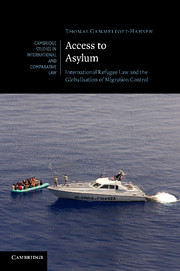Book contents
- Frontmatter
- Contents
- Foreword
- Preface
- Acknowledgements
- Table of treaties and other international instruments
- Table of cases
- 1 Introduction
- 2 The refugee and the globalisation of migration control
- 3 Refugee protection and the reach of the non-refoulement principle
- 4 Offshore migration control and the concept of extraterritorial jurisdiction
- 5 The privatisation of migration control and state responsibility
- 6 ‘Hic abundant leones’: the institutional reach of refugee protection
- 7 Conclusion
- Bibliography
- Index
- CAMBRIDGE STUDIES IN INTERNATIONAL AND COMPARATIVE LAW
7 - Conclusion
Published online by Cambridge University Press: 03 May 2011
- Frontmatter
- Contents
- Foreword
- Preface
- Acknowledgements
- Table of treaties and other international instruments
- Table of cases
- 1 Introduction
- 2 The refugee and the globalisation of migration control
- 3 Refugee protection and the reach of the non-refoulement principle
- 4 Offshore migration control and the concept of extraterritorial jurisdiction
- 5 The privatisation of migration control and state responsibility
- 6 ‘Hic abundant leones’: the institutional reach of refugee protection
- 7 Conclusion
- Bibliography
- Index
- CAMBRIDGE STUDIES IN INTERNATIONAL AND COMPARATIVE LAW
Summary
Recapitulation
This book started by asking the simple question: when does a refugee encounter the state? As a matter of practice something is clearly changing in the encounter between the asylum-seeker and the potential asylum state. Rather than the traditional image of the refugee arriving at the border and claiming asylum with national authorities, more and more often asylum-seekers find themselves confronted with measures of migration control before arriving at their prospective destination state and with controls carried out by agents other than the state's own authorities.
Throughout the preceding chapters an attempt has been made to give examples of these practices. It has been argued that ‘offshore’ and ‘outsourcing’ migration control is not just a growing trend among both old and new asylum and immigration countries; it may well be a systemic feature of the world we currently inhabit and as such finds parallels in a number of other fields.
The driving force behind this volume has been to ask whether this de facto shift in location and actors for the encounter between the refugee and the state is accompanied by an equal de jure shift in the reach of international refugee law. To what extent are states bound by international refugee and human rights obligations when carrying out extraterritorial migration control or delegating control functions to private actors?
- Type
- Chapter
- Information
- Access to AsylumInternational Refugee Law and the Globalisation of Migration Control, pp. 231 - 248Publisher: Cambridge University PressPrint publication year: 2011

